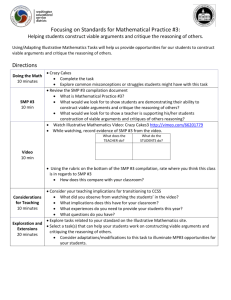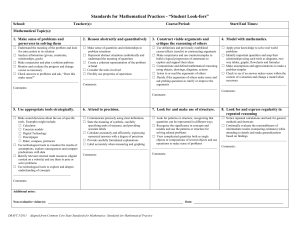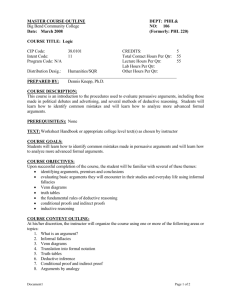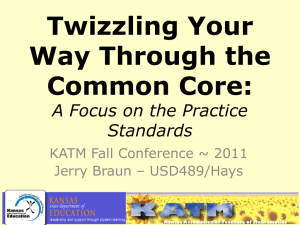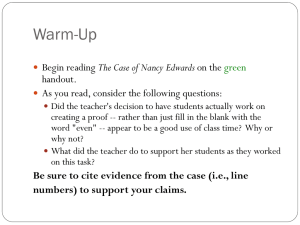Handout 9
advertisement
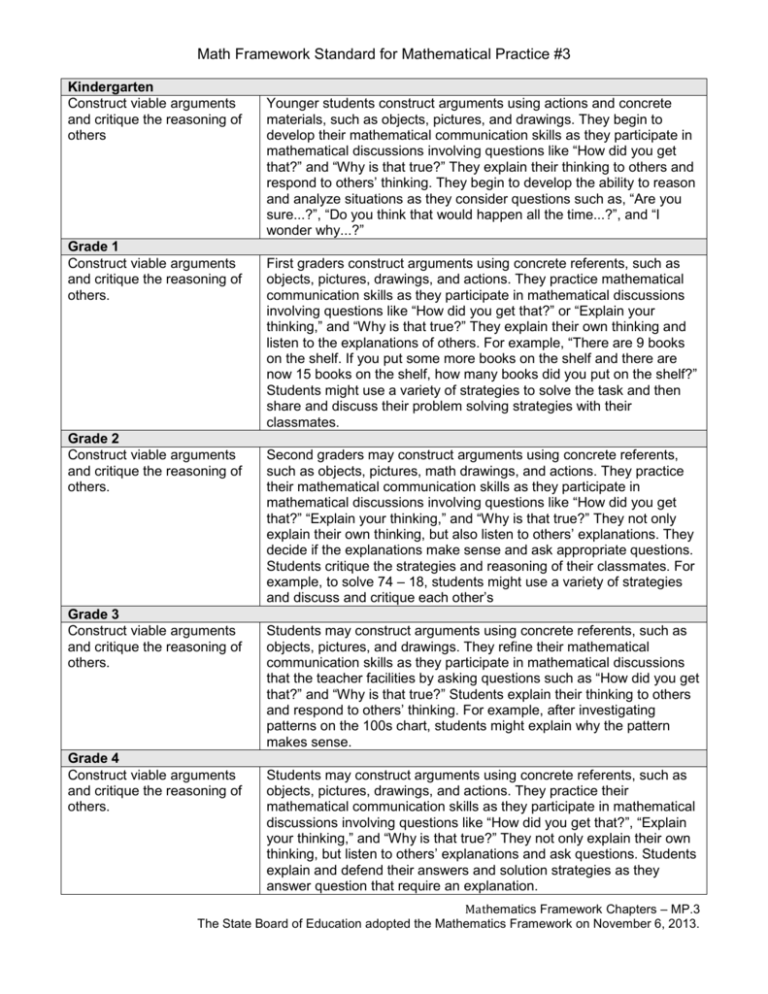
Math Framework Standard for Mathematical Practice #3 Kindergarten Construct viable arguments and critique the reasoning of others Grade 1 Construct viable arguments and critique the reasoning of others. Grade 2 Construct viable arguments and critique the reasoning of others. Grade 3 Construct viable arguments and critique the reasoning of others. Grade 4 Construct viable arguments and critique the reasoning of others. Younger students construct arguments using actions and concrete materials, such as objects, pictures, and drawings. They begin to develop their mathematical communication skills as they participate in mathematical discussions involving questions like “How did you get that?” and “Why is that true?” They explain their thinking to others and respond to others’ thinking. They begin to develop the ability to reason and analyze situations as they consider questions such as, “Are you sure...?”, “Do you think that would happen all the time...?”, and “I wonder why...?” First graders construct arguments using concrete referents, such as objects, pictures, drawings, and actions. They practice mathematical communication skills as they participate in mathematical discussions involving questions like “How did you get that?” or “Explain your thinking,” and “Why is that true?” They explain their own thinking and listen to the explanations of others. For example, “There are 9 books on the shelf. If you put some more books on the shelf and there are now 15 books on the shelf, how many books did you put on the shelf?” Students might use a variety of strategies to solve the task and then share and discuss their problem solving strategies with their classmates. Second graders may construct arguments using concrete referents, such as objects, pictures, math drawings, and actions. They practice their mathematical communication skills as they participate in mathematical discussions involving questions like “How did you get that?” “Explain your thinking,” and “Why is that true?” They not only explain their own thinking, but also listen to others’ explanations. They decide if the explanations make sense and ask appropriate questions. Students critique the strategies and reasoning of their classmates. For example, to solve 74 – 18, students might use a variety of strategies and discuss and critique each other’s Students may construct arguments using concrete referents, such as objects, pictures, and drawings. They refine their mathematical communication skills as they participate in mathematical discussions that the teacher facilities by asking questions such as “How did you get that?” and “Why is that true?” Students explain their thinking to others and respond to others’ thinking. For example, after investigating patterns on the 100s chart, students might explain why the pattern makes sense. Students may construct arguments using concrete referents, such as objects, pictures, drawings, and actions. They practice their mathematical communication skills as they participate in mathematical discussions involving questions like “How did you get that?”, “Explain your thinking,” and “Why is that true?” They not only explain their own thinking, but listen to others’ explanations and ask questions. Students explain and defend their answers and solution strategies as they answer question that require an explanation. Mathematics Framework Chapters – MP.3 The State Board of Education adopted the Mathematics Framework on November 6, 2013. Grade 5 Construct viable arguments and critique the reasoning of others. Grade 6 Construct viable arguments and critique the reasoning of others. Grade 7 Construct viable arguments and critique the reasoning of others. Grade 8 Construct viable arguments and critique the reasoning of others. In fifth grade students may construct arguments using visual models, such as objects and drawings. They explain calculations based upon models, properties of operations and rules that generate patterns. They demonstrate and explain the relationship between volume and multiplication. They refine their mathematical communication skills as they participate in mathematical discussions involving questions like “How did you get that?” and “Why is that true?” They explain their thinking to others and respond to others’ thinking. Students use various strategies to solve problems and they defend and justify their work with others. For example, two afterschool clubs are having pizza parties. The teacher will order 3 pizzas for every 5 students in the math club; and 5 pizzas for every 8 students in the student council. If a student is in both groups, decide which party he/she should to attend. How much pizza will each student get at each party? If a student wants attend the party with the most pizza (if divided equally between the students at the party), which party should he/she attend? Students construct arguments using verbal or written explanations accompanied by expressions, equations, inequalities, models, and graphs, tables, and other data displays (e.g., box plots, dot plots, histograms). They further refine their mathematical communication skills through mathematical discussions in which they critically evaluate their own thinking and the thinking of other students. They pose questions like “How did you get that?”, “Why is that true?” and “Does that always work?” They explain their thinking to others and respond to others’ thinking. Students construct arguments using verbal or written explanations accompanied by expressions, equations, inequalities, models, and graphs, and tables. They further refine their mathematical communication skills through mathematical discussions in which they critically evaluate their own thinking and the thinking of other students. For example, as students notice when given geometric conditions determine a unique triangle, more than one triangle or no triangle (7.G.2), they have an opportunity to construct viable arguments and critique the reasoning of others. Students should be encouraged to answer questions, such as “How did you get that?”, “Why is that true?” and “Does that always work?” Students construct arguments using verbal or written explanations accompanied by expressions, equations, inequalities, models, and graphs, tables, and other data displays (e.g., box plots, dot plots, histograms). They further refine their mathematical communication skills through mathematical discussions in which they critically evaluate their own thinking and the thinking of other students. They pose questions like “How did you get that?”, “Why is that true?” and “Does that always work? ”They explain their thinking to others and respond to others’ thinking. Mathematics Framework Chapters – MP.3 The State Board of Education adopted the Mathematics Framework on November 6, 2013. Algebra 1/ Mathematics 1 Construct viable arguments Students reason through the solving of equations, recognizing that and critique the reasoning of solving an equation is more than simply a matter of rote rules and others. steps. They use language such as “if… then...” when explaining their Students build proofs by solution methods and provide justification. induction and proofs by contradiction. CA 3.1 (for higher mathematics only). Geometry Construct viable arguments Students construct proofs of geometric theorems. They write coherent and critique the reasoning of logical arguments and understand that each step in a proof must follow others. Students build from the last, justified with a previously accepted or proven result. proofs by induction and proofs by contradiction. CA 3.1 (for higher mathematics only). Mathematics 2 Construct viable arguments Students construct proofs of geometric theorems based on and critique the reasoning of congruence criteria of triangles. They understand and explain the others. Students build definition of radian measure. proofs by induction and proofs by contradiction. CA 3.1 (for higher mathematics only). Algebra 2/ Mathematics 3/ Precalculus Construct viable arguments Students continue to reason through the solution of an equation and and critique the reasoning of justify their reasoning to their peers. Students defend their choice of a others. Students build function to model a real world situation. proofs by induction and proofs by contradiction. CA 3.1 (for higher mathematics only). Statistics and Probability Construct viable arguments Students defend their choice of a function to model data. Students pay and critique the reasoning of attention to the precise definitions of concepts such as causality and others. Students build correlation and learn how to discern between the two, becoming aware proofs by induction and of potential abuses of statistics. proofs by contradiction. CA 3.1 (for higher mathematics only). Assessment Chapter Journals and Learning Logs are tools in which students do mathematical writing that serves to illuminate their current understandings. For example, a teacher may provide each student with a journal that is kept in the classroom, which is then used for students to solve an “exit problem” of the day. Or students may be asked to explain what they learned that given day or what they think the major idea of the lesson was. Such journals have a variety of uses. Teachers should not feel required to grade everything in the math journal; in fact, this may diminish its use as students feel they need to write a “correct response.” Instead, teachers can simply read all or some of their students’ journals to get feedback on student understanding. Mathematics Framework Chapters – MP.3 The State Board of Education adopted the Mathematics Framework on November 6, 2013.


